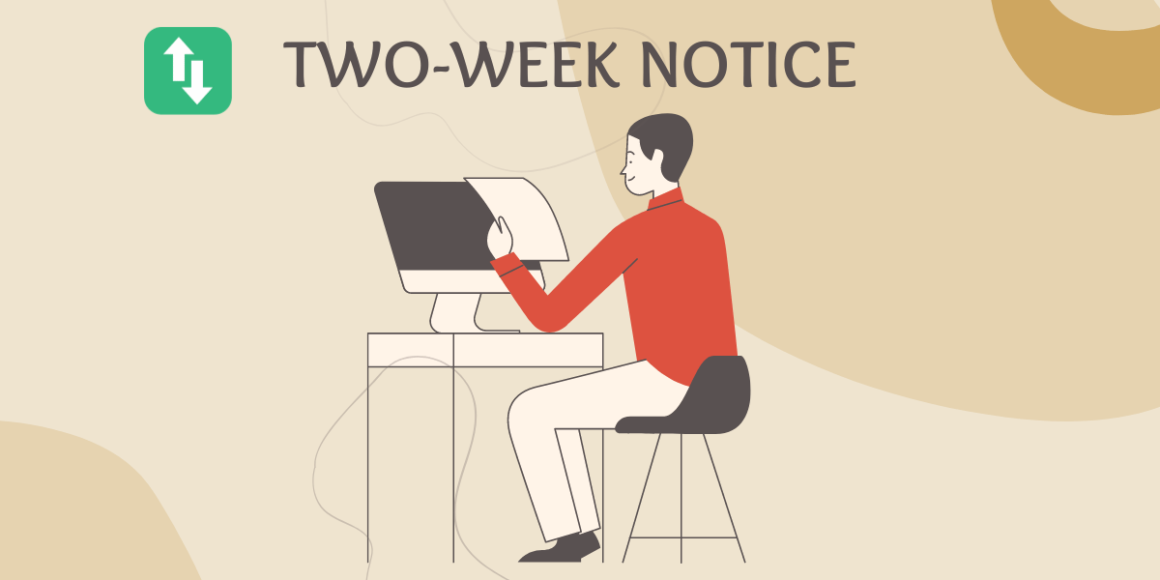Table of Contents Show
Giving a two-week notice is a critical step in the professional world, formally announcing your intention to resign from your current position.
It’s a matter of professional etiquette that helps maintain positive relationships and ensures a smooth transition.
Whether moving on to a new job, relocating, or taking time off for personal reasons, informing your employer with adequate notice is not just considerate but often essential.
Read this blog to know what is a two-week notice and how to put it with templates, and examples.
What Is A Two-Week Notice?
A two-week notice is a written statement that announces your intention to leave your current job, effective two weeks from the date of the notice. This period allows your employer to begin finding your replacement and planning for your departure.
Legally, while most employment is “at-will” and can technically be terminated at any time by either party, giving notice is a professional courtesy that reflects well on you as an employee.
Failing to provide a 2-week notice can lead to strained relationships and potentially burn bridges that you might need in the future. Moreover, in some industries, it could impact your professional reputation and make future job searches more challenging.
When and Why to Give a Two-Week Notice?
You should give a two-week notice in several scenarios, including when you’ve accepted a new job offer, are relocating, need to attend to personal matters, or are pursuing further education.
Providing a notice benefits both you and your employer. It ensures that you leave on good terms, preserving professional relationships and potential references.
It also gives your employer time to find a replacement or redistribute your tasks, ensuring minimal disruption to the workflow.
Failing to give proper notice can result in unfinished projects, disgruntled colleagues, and a negative mark on your professional reputation. It’s a simple yet effective way to demonstrate your professionalism and respect for your current employer.
Preparing to Write Your Two-Week Notice
Before you sit down to write your two-week notice, gather all the necessary information. This includes your employment details, such as your job title, the name of your supervisor, and your expected last day of work. Calculate your final working day accurately, typically two weeks from the day you submit your notice.
Reflect on your reasons for leaving and ensure they are clear and concise in your letter. Whether you’re leaving for a better opportunity, relocating, or for personal reasons, having a solid understanding of your motives will help you communicate more effectively.
How to Write a Two-Week Notice Letter?
Your two-week notice letter should be straightforward and professionally formatted. Here are the key elements to include:
- Date: The date when you are writing the letter.
- Recipient’s Name and Position: Address the letter to your immediate supervisor or the relevant authority.
- Clear Statement of Resignation: Explicitly state that you are resigning from your position.
- Last Working Day: Specify your last day of work, which should be two weeks from the date of the notice.
- Offer of Assistance: Offer to help with the transition process.
- Expression of Gratitude: Thank your employer for the opportunity to work with the company.
- Signature: Sign the letter to give it a personal touch.
Two-Week Notice Letter Examples
Here are some examples to guide you in writing the notice:
Formal Example:
[Your Name] [Your Address] [City, State, ZIP Code] [Email Address] [Today’s Date] [Recipient’s Name] [Company Name] [Company Address] [City, State, ZIP Code] Dear [Recipient’s Name], I am writing to formally notify you of my resignation from [Company Name], effective [Last Working Day, two weeks from today]. This decision has not been easy, and I am grateful for the opportunities and experiences I have had during my time here. I am committed to ensuring a smooth transition and am willing to assist in training my replacement or handing over my responsibilities to ensure a seamless process. Thank you for your understanding and support. Sincerely, [Your Name]
Informal Example for 2-week notice:
Hi [Recipient’s Name], I hope you’re well. I wanted to let you know that I will be resigning from my position at [Company Name], effective [Last Working Day, two weeks from today]. I’ve really enjoyed my time here and appreciate all the opportunities I’ve had to grow and learn. I’m happy to help with the transition in any way I can over the next two weeks. Thanks so much, [Your Name]
Email Example for two-week notice:
Subject: Resignation Notice - [Your Name] Dear [Recipient’s Name], I am writing to inform you of my resignation from [Company Name], effective [Last Working Day, two weeks from now]. I have appreciated my time at [Company Name] and am grateful for the experiences and opportunities I’ve had. I will do my best to ensure a smooth transition and am available to assist in any way needed during my remaining time here. Thank you for your understanding. Best regards, [Your Name]
Tips for Writing a 2-Week Notice Letter
- Keep it brief and to the point: Your letter should be concise, clearly stating your intention to resign.
- Maintain a professional tone: Avoid any negative remarks about the company or colleagues.
- Be honest but diplomatic: State your reasons for leaving without going into unnecessary detail.
- Avoid burning bridges: Leave on a positive note, expressing gratitude for the opportunities you’ve had.
- Proofread before sending: Ensure there are no typos or errors in your letter.
Delivering Your 2-Week Notice

Want to know how to put in two-week notice? Read further…
The way you deliver your notice can be as important as the content of the notice itself. If possible, deliver your notice in person. This shows respect and gives you the chance to have a direct conversation with your employer. If in-person delivery isn’t feasible, sending your notice via email is acceptable.
Choose an appropriate time to deliver your notice, ideally at the beginning or end of the workday when your boss might have more time to discuss it with you. Be prepared for various reactions, from understanding and support to surprise and disappointment.
Navigating the Final Two Weeks
After delivering your notice, continue to perform your duties diligently. This period is critical for maintaining your professional image. Complete any ongoing projects, document your work processes, and help train your replacement if necessary. This shows your commitment to the company and your respect for your colleagues.
Saying goodbye to colleagues can be emotional, but it’s important to do so in a professional manner. Express your gratitude for their support and keep in touch for future networking opportunities. Finally, ensure all necessary paperwork and exit procedures are completed before your last day.
Conclusion
Providing a two-week notice is a fundamental aspect of professional conduct. It allows for a smooth transition, helps maintain positive relationships, and preserves your professional reputation.
By following the guidelines and examples provided, you can leave your current job with dignity and respect, paving the way for future opportunities. Share your feedback at hi@productivityshift.com
Frequently Asked Questions On Putting A 2 Week Notice
Why is it important to give a two-week notice?
Giving a two-week notice helps maintain a positive relationship with your employer, ensures a smooth transition for your team, and preserves your professional reputation. It shows respect and professionalism.
When should I give my two-week notice?
You should give your two-week notice as soon as you have made the final decision to leave your job and have confirmed your plans with your new employer or next steps. Ideally, it should be given at least two weeks before your intended last day of work.
What should be included in a two-week notice letter?
A two-week notice letter should include:
- The date
- Your supervisor’s name and position
- A clear statement of resignation
- Your last working day
- An offer to assist with the transition
- An expression of gratitude
- Your signature
Can I give more than two weeks’ notice?
Yes, if you are able and willing to provide more than two weeks’ notice, it can be beneficial to your employer. This extra time can help ensure a smoother transition and demonstrate your professionalism.
What if my employer reacts negatively to my notice?
It’s important to stay calm and professional regardless of your employer’s reaction. Reiterate your willingness to help with the transition and focus on maintaining a positive tone. Remember, the way you leave a job can impact your professional reputation.
Should I explain my reasons for leaving in my notice letter?
While it’s not necessary to go into detail about your reasons for leaving in your notice letter, a brief, positive explanation can be included. Keep it concise and professional.
Can I retract my two-week notice if I change my mind?
f you change your mind after submitting your notice, communicate with your employer as soon as possible. However, be aware that your employer may have already started making plans for your departure, so they may not be able to accommodate your request.
What should I do during my final two weeks?
During your final two weeks, continue to work diligently, complete any ongoing projects, document your work processes, and help train your replacement if necessary. This shows your commitment to the company and ensures a smooth transition.
You May Also Like:










